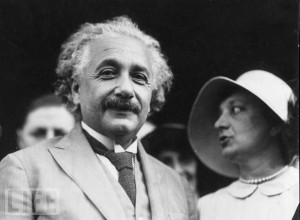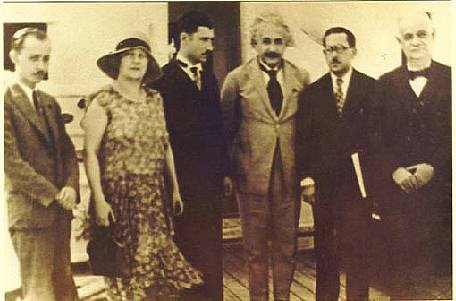Albert Einstein was born at Ulm, in Württemberg, Germany, on March 14, 1879. Six weeks later the family moved to Munich, where he later on began his schooling at the Luitpold Gymnasium. Later, they moved to Italy and Albert continued his education at Aarau, Switzerland and in 1896 he entered the Swiss Federal Polytechnic School in Zurich to be trained as a teacher in physics and mathematics.
He became a German citizen in 1914 and remained in Berlin until 1933 when he renounced his citizenship for political reasons and emigrated to America to take the position of Professor of Theoretical Physics at Princeton*. With only 24 years, published his first paper on the Theory of Relativity, of paramount importance for modern science, which completed a decade later with the famous general theory, which became, in fact, the greatest theoretical physicist of the twentieth century.
He gained numerous awards in recognition of his work, including the Copley Medal of the Royal Society of London in 1925, and the Franklin Medal of the Franklin Institute in 1935. He became a United States citizen in 1940 and retired from his post in 1945.
Visiting Cuba
The year was 1920, and its end is approaching and to make way for a new one … But a momentous visit would alter the scientific community in Havana.
On 19 December, after a stay in New York city where he attended events organized in his honor-Cuban soil trod the famous German physicist, Albert Einstein, who was received by the most important figures of science in the country. His apparent desire to know the capital city became reality.
El Heraldo de Cuba, published at the time, I would describe it thus: “Broad forehead crowning matted hair almost white, protruding chin, willful and strong, thick lips and large eyes and light purple to dark circles semicirculados of force, apparently fixing in infinite points ancestral perhaps he just looks and only knows how to define, to hang them the golden child of his theory demolition of the exact sciences, Dr. Einstein inspires deep respect and admiration that is evident from the heroes and demigods of mythology … “.
One and a half was among us, and just got made several requests to their Cuban counterparts: a cool hat to support our sun and go to the slums. The next day the people were astonished at the unusual spectacle of well-known European, wearing a Panama hat which ran the Single Market more modest stores of the Avenue of Jesus del Monte and the poorest neighborhoods: Pan con Timba and comes and Pon, whose solar and rooming penetrated the great scientist. The day before, had led him to places frequented by the wealthier class of country residences, clubs, parks …
The short period of their visit was to scientists there was a great source of pride, for sharing with a man as great and simple without pose wise so that they invited him to the Geographical Society, the Academy of Sciences and Cuban Society of Engineers, among others, to pay special tribute.
While in the Academy of Geography said he felt satisfied with the receptions made, both by scientists and by the people of Havana, the capital of “the Island so picturesque that I visit with pleasure,” if only a few hours.
Their journey had exchanges in the Cup of Vento and water intake Aguada del Cura, the Ministry of Health, Calixto Garcia Hospital and Institute of Oncology, places where they showed great interest.
“The first society was truly universal society of researchers. Hopefully the next generation to establish an economic partnership and political regularly to prevent disasters,” he wrote in the Golden Book of the Geographical Society, the eminent man of science.
Einstein’s gifts inevitably resulted in his dwelling much in intellectual solitude and, for relaxation, music played an important part in his life. He married Mileva Maric in 1903 and they had a daughter and two sons; their marriage was dissolved in 1919 and in the same year he married his cousin, Elsa Löwenthal, who died in 1936. He died on April 18, 1955 at Princeton, New Jersey.
Sources: Wiki/NobelPrizeOrg/CaroNodarse/InternetPhotos/TheCubanHistory.com
Albert Einstein in Cuba/ The Cuban History/ Arnoldo Varona, Editor
ALBERT EINSTEIN EN CUBA
Albert Einstein nació en Ulm, en Württemberg, Alemania, el 14 de marzo de 1879. Seis semanas más tarde la familia se trasladó a Munich, donde más tarde comenzó sus estudios en el Gymnasium Luitpold. Más tarde, se trasladó a Italia y Albert continuó su educación en Aarau, Suiza y en 1896 ingresó en la Escuela Politécnica Federal de Suiza en Zurich para ser entrenado como un maestro en física y matemáticas.
Se convirtió en un ciudadano alemán en 1914 y permaneció en Berlín hasta 1933, cuando renunció a su ciudadanía por razones políticas y emigró a Estados Unidos para ocupar el cargo de Profesor de Física Teórica en Princeton. Con sólo 24 años, publicó su primer artículo sobre la Teoría de la Relatividad, de vital importancia para la ciencia moderna, que completó una década después con la famosa teoría general, que se convirtió, de hecho, el mayor físico teórico del siglo XX.
Ganó numerosos premios en reconocimiento a su labor, incluyendo la Medalla Copley de la Royal Society de Londres en 1925, y la Medalla Franklin del Instituto Franklin en 1935. Se convirtió en ciudadano de los Estados Unidos en 1940 y se retiró de su cargo en 1945.
Su estancia en Cuba
Corría el año 1920, y sus finales se aproximaban ya para darle paso a uno nuevo… Pero, una visita trascendental alteraría la comunidad científica de La Habana.
El día 19 de diciembre, – tras una estadía en New York para asistir a los actos organizados en su honor-, pisaba tierra cubana el famoso físico alemán, Albert Einstein, quien fuera recibido por las más importantes figuras de la ciencia en el país. Su manifiesto deseo de conocer a la urbe capitalina se hacía realidad.
Dotado de elevados sentimientos, intervino fehacientemente en favor de la paz, lo que le valió para adjudicarse el Premio Nóbel en 1924.
El Heraldo de Cuba, publicación de la época, lo describiría así: “Amplia la frente que coronan enmarañados cabellos casi blancos; saliente el mentón, voluntarioso y firme, gruesos los labios y grandes, y claros los ojos semicirculados de ojeras violáceas a fuerza, parece, de fijarlos en infinitos puntos ancestrales que él acaso sólo mira y sólo sabe definir, para colgar de ellos el hijo de oro de su teoría demoledora de las ciencias exactas, el doctor Einstein inspira ese respeto y admiración profunda que se desprende de los héroes y semidioses de las mitologías…”.
Un día y medio estuvo entre nosotros, y apenas llegó realizó varias solicitudes a sus homólogos cubanos: un sombrero fresco para soportar nuestro sol y concurrir a los barrios pobres. Al día siguiente los pobladores se asombraban ante el no común espectáculo del conocidísimo europeo, el cual luciendo un sombrero jipijapa recorría el Mercado Único, las tiendas más modestas de la Calzada de Jesús del Monte y los más pobres barrios: Pan con Timba y Llega y Pon, en cuyos solares y cuarterías penetró el genial científico. En la víspera, lo habían conducido a los lugares frecuentados por la clase más acomodada del país: residencias, clubes, parques…
El poco tiempo que duró su visita constituyó para los científicos de entonces un tremendo motivo de orgullo, por haber compartido con un hombre tan grande y sencillo sin pose de sabio; es así que lo invitaron a la Sociedad Geográfica, a la Academia de Ciencias y la Sociedad Cubana de Ingenieros, entre otras instituciones, para rendirle especial homenaje.
Durante su estancia en la Academia de Geografía expresó sentirse satisfecho por los recibimientos realizados, tanto por parte de los hombres de ciencia como por el pueblo de La Habana, la capital de “esta Isla tan pintoresca que visito con placer”, aunque sólo fuera por unas pocas horas.
Su periplo contó con intercambios en la Taza del Vento y la toma de agua de Aguada del Cura, la Secretaría de Sanidad, el hospital Calixto García y el Instituto de Oncología, lugares en los que mostró un gran interés.
“La primera sociedad verdaderamente universal fue la sociedad de los investigadores. Ojalá pueda la generación venidera establecer una sociedad económica y política que evite con regularidad las catástrofes”, escribiría en el Libro de Oro de la Sociedad Geográfica, el eminente hombre de ciencias.
Los regalos de Einstein, inevitablemente, tambien fueron acompañados de una soledad intelectual en su vivienda y para relajarse, la música jugó un papel importante en su vida. Se casó con Mileva Maric en 1903 y tuvieron una hija y dos hijos, su matrimonio se disolvió en 1919 y en el mismo año se casó con su prima Elsa Lowenthal, quien murió en 1936. Albert Einstein murió el 18 de abril de 1955, en Princeton, Nueva Jersey, Estados Unidos.
Sources: Wiki/NobelPrizeOrg/CaroNodarse/InternetPhotos/TheCubanHistory.com
Albert Einstein in Cuba/ The Cuban History/ Arnoldo Varona, Editor






